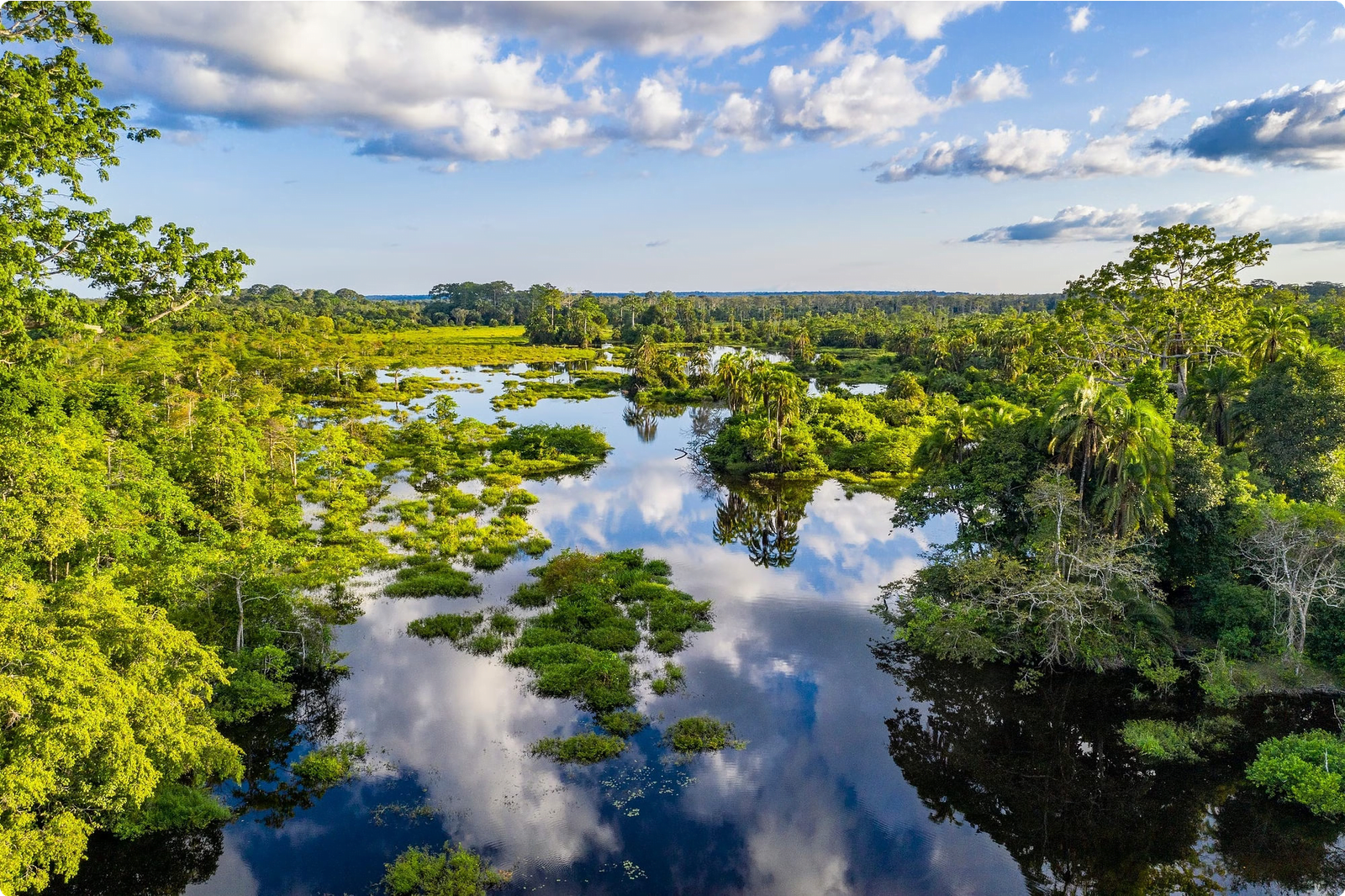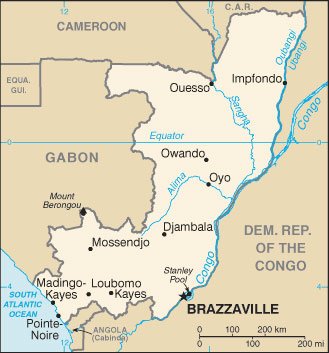Congo
Discover Congo
Congo, officially known as the Republic of the Congo, is a country located in Central Africa. It is bordered by Gabon, Cameroon, the Central African Republic, the Democratic Republic of the Congo, and the Angolan exclave province of Cabinda. The capital city is Brazzaville, situated on the Congo River, and the official language is French. The country is known for its rich cultural heritage, breathtaking landscapes, and diverse wildlife.

From lush rainforests to vibrant cities, Congo offers a unique blend of traditional and modern experiences. Its vibrant culture, lively music and dance, and delicious cuisine make it a captivating destination for travelers seeking adventure and cultural immersion.
Currency of Congo
Congolese Franc (CDF): The official currency of Congo is the Congolese Franc, denoted by the symbol “FC” or “CDF”. It is the primary form of legal tender used in daily transactions across the country.
Banknotes and Coins: The currency is available in banknotes of various denominations, including 10, 20, 50, 100, 200, 500, 1000, 2000, 5000, and 10000 francs. Additionally, coins in smaller denominations are also in circulation.
Exchange Rate: The exchange rate of the Congolese Franc fluctuates and is often compared to other major currencies, impacting international trade and financial transactions.
Economy of Congo
Congo, officially known as the Democratic Republic of the Congo, is a country in Central Africa that boasts an abundance of natural resources. The economy of Congo is heavily reliant on its vast reserves of natural wealth, including minerals such as cobalt, coltan, and copper. These resources play a significant role in driving the country’s economic growth and development.
The agricultural sector also plays a crucial role in the economy, with a focus on crops such as coffee, palm oil, and rubber. Additionally, Congo has a burgeoning energy sector, harnessing the power of its abundant water resources for hydroelectric power generation.
The country faces challenges related to infrastructure development, governance, and political stability, which impact the overall economic landscape. Despite these challenges, Congo continues to strive for economic diversification and sustainable growth, aiming to improve the standard of living for its citizens and contribute to the global economy.
Culture of Congo
The diverse and vibrant culture of Congo is deeply influenced by the various ethnic groups and their traditions. With over 200 ethnic groups, the country boasts a rich tapestry of customs, languages, and artistic expressions. Traditional attire, such as the colorful and intricately designed “pagne” (wrap- around cloth), reflects the unique identity of each community. Congo’s music, including soukous and rumba, has gained international recognition, adding to the cultural significance of the nation.
Artisanal crafts, such as wood carvings and pottery, showcase the creativity and craftsmanship of Congolese artisans. Additionally, storytelling and oral traditions play a vital role in preserving the history and folklore of the country, passing down knowledge from generation to generation. The culinary scene of Congo is characterized by a variety of flavorful dishes, with ingredients like cassava, plantains, and peanuts forming the base of many traditional recipes.
Furthermore, Congo’s festivals and ceremonies, such as the vibrant “Lukasa” initiation ceremony of the Luba people, offer a glimpse into the deeply rooted cultural practices. The fusion of indigenous beliefs with Christianity also influences the spiritual landscape, as seen in ceremonies and rituals. Overall, the culture of Congo is a dynamic and multifaceted tapestry that continues to evolve while cherishing its heritage.
Traditional Dances in Congo
Kwasa Kwasa: This is a popular dance style that originated in the Democratic Republic of Congo in the late 20th century. It features quick, rhythmic hip movements and is often accompanied by energetic music.

Ndombolo: Originating in Kinshasa, Ndombolo is known for its fast-paced hip-swinging movements. It gained international popularity in the 1990s and is still a vibrant part of Congolese culture.
Soukous: Also known as Congo music, Soukous is a genre of dance music that originated in the two countries of Congo. It is characterized by a pulsating rhythm and lively dance moves.
Tshigombela: This traditional dance from the Luba tribe involves graceful movements and storytelling through dance, often accompanied by traditional Luba music.
Famous Congolese Dishes
Mbika-mbika: This is a traditional Congolese dish made with cassava leaves, peanut butter, onions, and fish or meat. The combination of rich flavors and textures makes it a favorite among locals and visitors alike.

Foufou: A staple in Congolese cuisine, foufou is a starchy side dish made from cassava or plantains. It is often served with fragrant stews and is loved for its comforting and filling nature.
Liboke: Liboke is a popular Congolese dish consisting of fish or meat, plantains, and a flavorful sauce wrapped in banana leaves and then steamed. The aroma and taste of the dish make it a must-try for food enthusiasts.
Flag of Congo
National Symbol
The flag of Congo is a powerful national symbol, representing the pride, history, and aspirations of the Congolese people. The vibrant colors and unique design hold deep cultural and historical significance, making it a source of unity and identity for the citizens of Congo.

Symbol of Independence
Each element of the flag, from the colors to the emblem, reflects the struggle for independence and the rich heritage of the country. It serves as a reminder of the sacrifices made to gain freedom and sovereignty, honoring the past while looking towards the future.
Celebratory Occasions
On national holidays and special events, the flag of Congo is proudly displayed, evoking a sense of patriotism and national pride. It is a symbol of unity that brings people together to celebrate the country’s achievements and cultural legacy.
Map of Congo
Political Map with Cities
The political map of Congo displays the boundaries of the country, including the major cities and their locations. It provides an overview of the administrative divisions and geographical details, offering valuable insight into the layout and distribution of important urban centers.
Physical Map
A physical map of Congo showcases the topography, terrain, and natural features such as rivers, mountains, and forests. It offers a comprehensive view of the country’s landforms, helping to understand its diverse landscapes and environmental characteristics.

Tourist Attractions Map
This map highlights the popular tourist destinations, landmarks, and attractions across Congo. It serves as a guide for travelers, depicting the cultural, historical, and natural sites that make Congo a captivating and enriching destination for exploration and adventure.
Best cities to visit in republic of Congo
Brazzaville
Brazzaville is the capital and largest city of the Republic of Congo. It is known for its vibrant culture, historic landmarks, and lively markets.
Pointe-Noire
Pointe-Noire is a coastal city and the economic hub of the country. It offers beautiful beaches, a bustling port, and a vibrant nightlife.
Dolisie
Dolisie is a city located in the heart of the country. It is known for its picturesque landscapes, including waterfalls and lush forests.
Ouesso
Ouesso is a city located in the northern part of the Republic of Congo. It is known for its stunning natural beauty, including lush rainforests and diverse wildlife.
Nkayi
Nkayi is a city nestled in the southwestern region of the country. It offers a rich cultural heritage, with traditional art and crafts, as well as vibrant local markets.
Brazzaville
Brazzaville, the capital city of the Republic of Congo, is situated on the banks of the mighty Congo River. It offers a vibrant mix of history, culture, and natural beauty. Visitors can explore historic landmarks, such as the Basilique Sainte-Anne and the Presidential Palace, and immerse themselves in the lively local markets. The city is also known for its lush green spaces, including the beautiful Brazzaville Botanical Garden. Experience the vibrant Congolese culture through traditional music, dance, and cuisine.

Pointe-Noire
Pointe-Noire is a vibrant coastal city in the Republic of Congo. Located on the Atlantic Ocean, it is known for its beautiful beaches, lively port, and bustling markets. The city offers a mix of modern amenities and rich cultural heritage. Visitors can indulge in delicious seafood, explore the local art scene, and enjoy the vibrant nightlife. Pointe-Noire is also a gateway to the stunning natural beauty of the Kouilou region, with its picturesque landscapes, wildlife, and national parks.

Dolisie
Dolisie is a city located in the southwestern part of the Republic of Congo. It is the third-largest city in the country and serves as a major transportation hub. Dolisie is known for its rich cultural heritage, vibrant markets, and friendly locals. Visitors can explore the city’s colonial architecture, visit the local museums, and experience the traditional music and dance performances. The surrounding area offers opportunities for hiking and wildlife spotting, with the lush forests and natural beauty of the region.
Dolisie is a must-visit destination for those looking to experience the authentic Congolese way of life.

Ouesso
Ouesso is a city located in the northern part of the Republic of Congo. It is known for its lush rainforests, diverse wildlife, and beautiful landscapes. The city serves as a gateway to the Odzala-Kokoua National Park, which is home to a wide variety of endangered species, including elephants, gorillas, and chimpanzees. Visitors to Ouesso can embark on exciting wildlife safaris, explore the pristine rivers and waterfalls, and immerse themselves in the rich biodiversity of the region. Ouesso offers a unique
opportunity to experience the natural wonders of Congo.

Nkayi
Nkayi is a city in the western part of the Republic of Congo. It is known for its rich cultural heritage, vibrant markets, and friendly locals. Visitors can explore the city’s colonial architecture, visit the local museums, and experience the traditional music and dance performances. The surrounding area offers opportunities for hiking and wildlife spotting, with the lush forests and natural beauty of the region. Nkayi is a must-visit destination for those looking to experience the authentic Congolese way of life.
